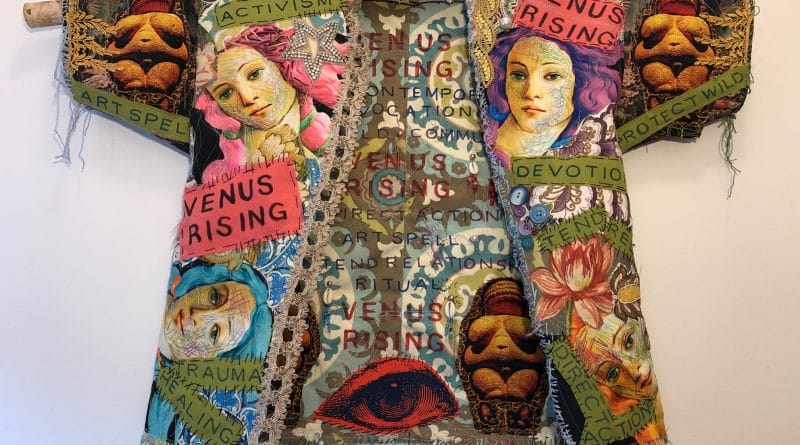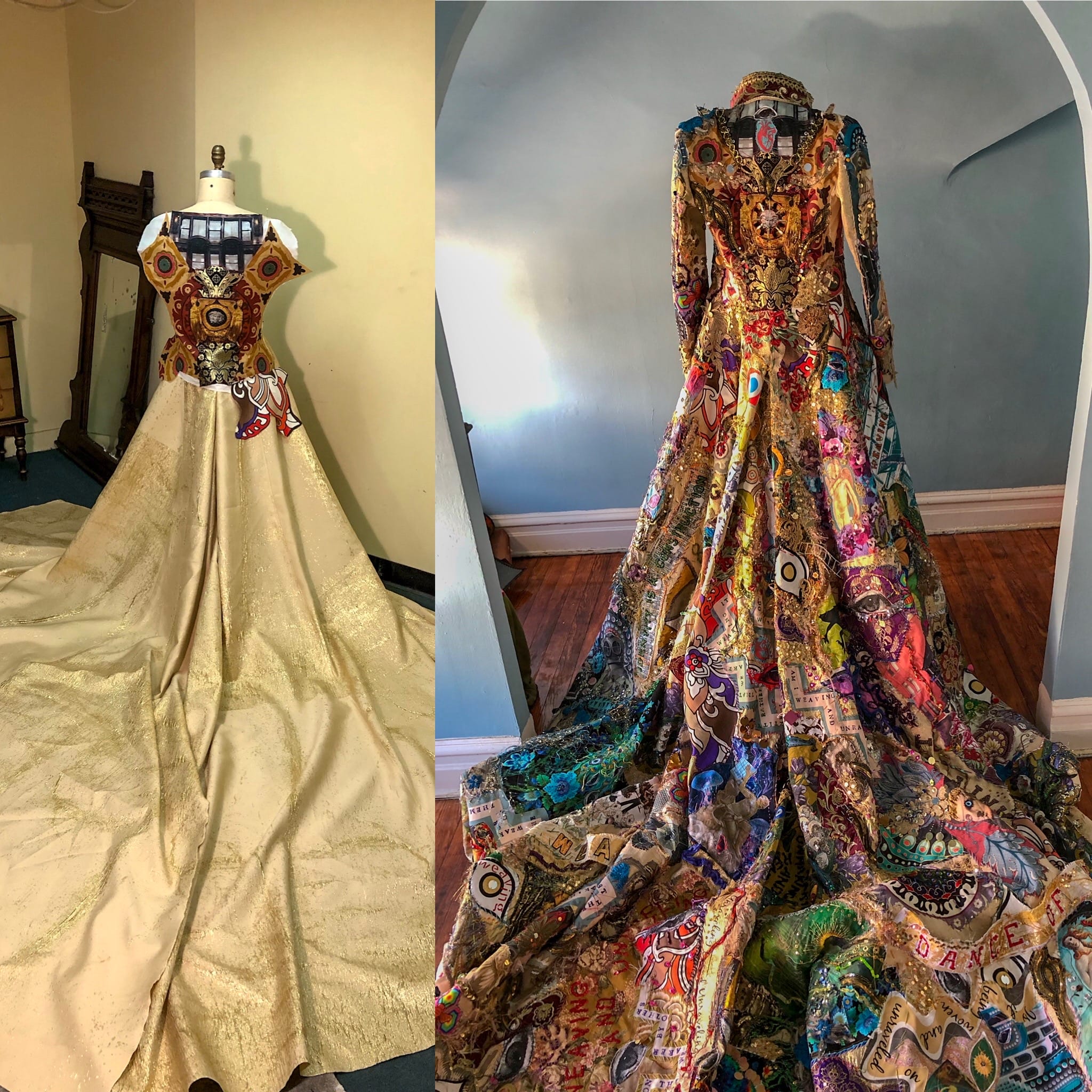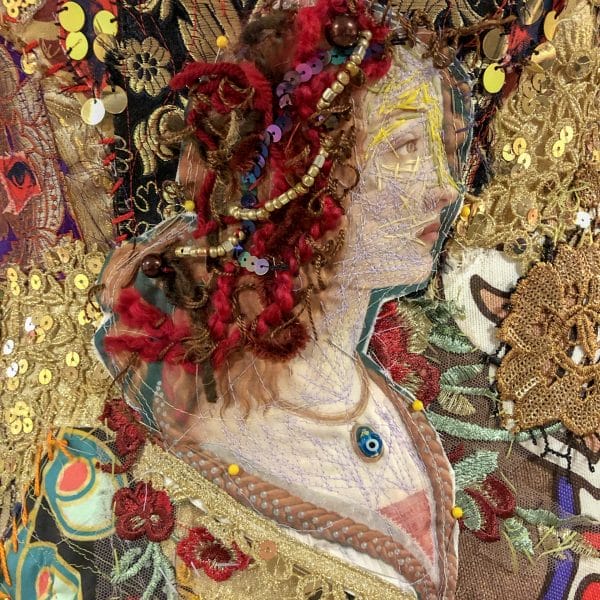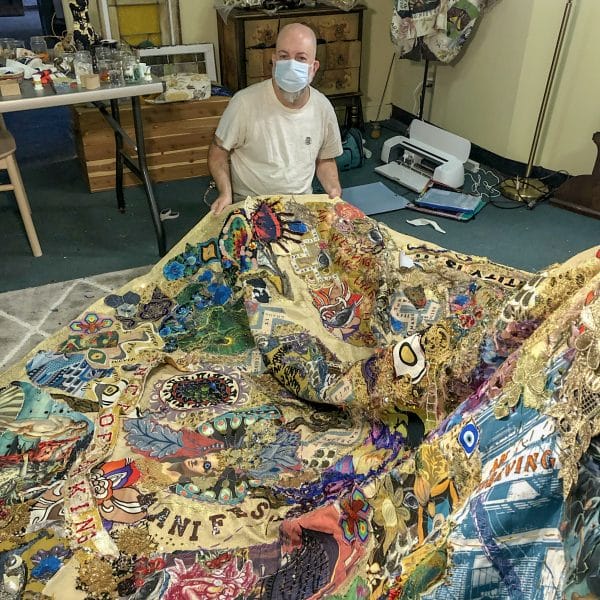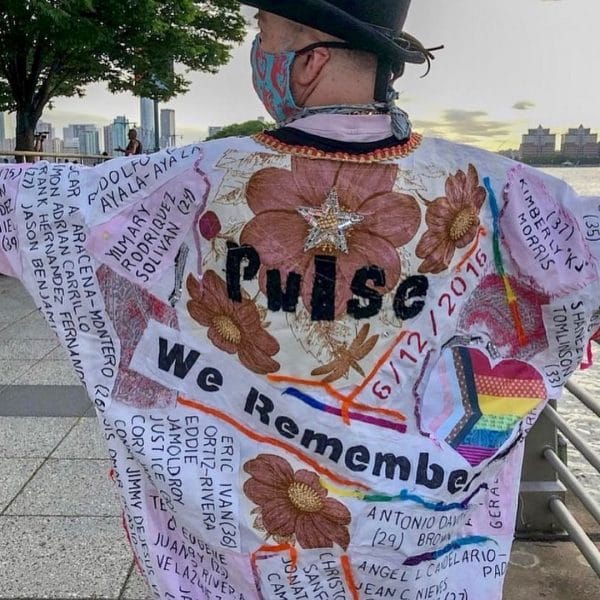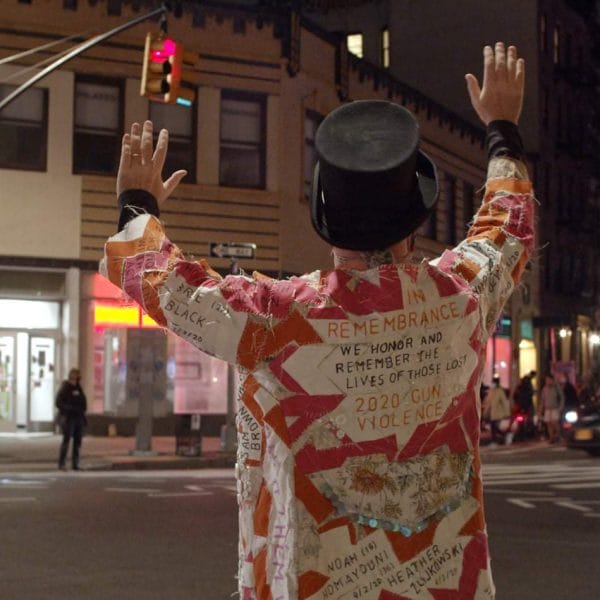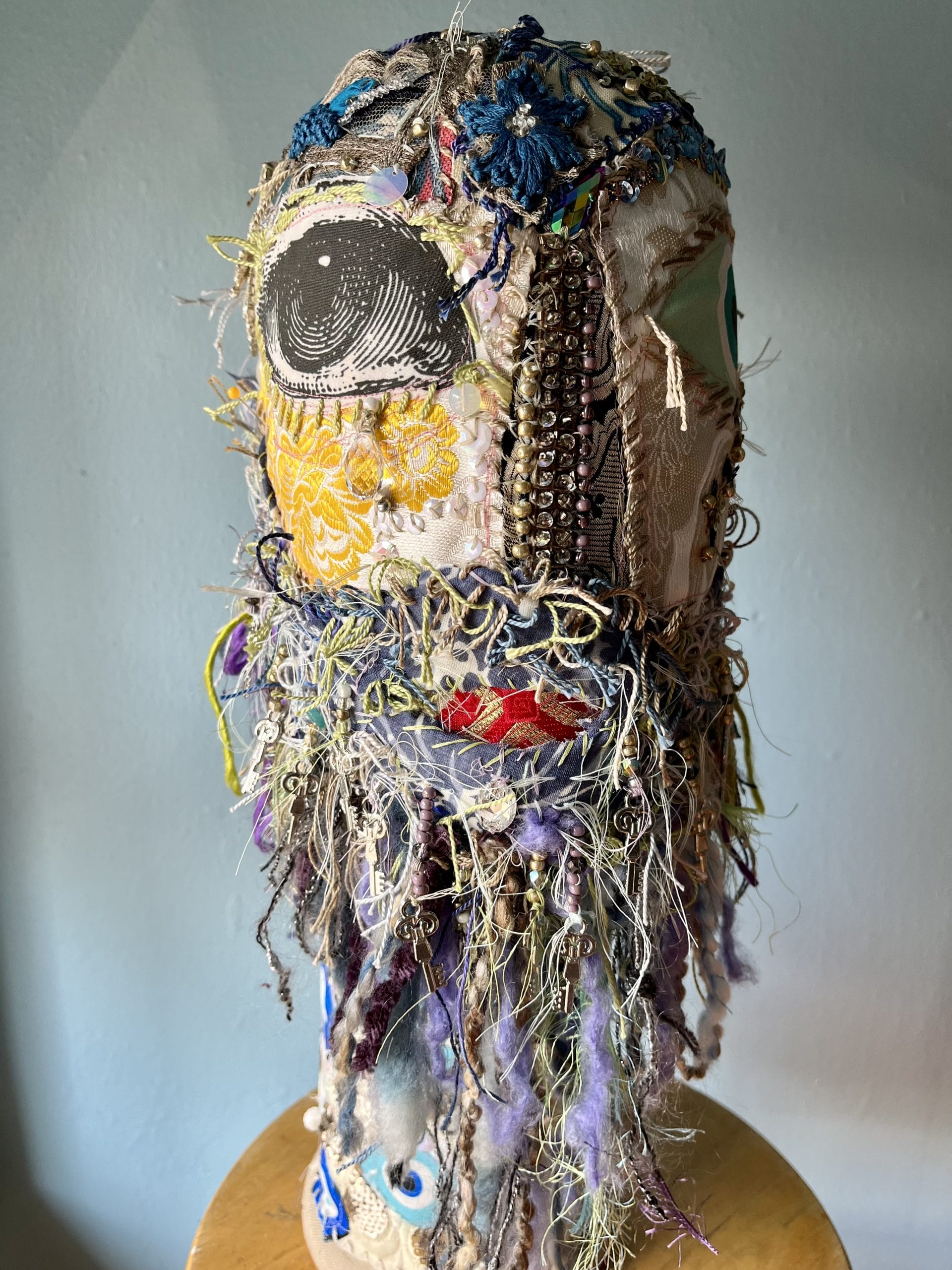MICHAEL SYLVAN ROBINSON
*Featured photo: Front view of “Venus Rising: a Contemporary Invocation” by Michael Sylvan Robinson. Sculptural garment, textile collage with machine and hand-stitching, beading, hand-stenciled poetic text 28″ x 38″ x 2″ (2019) was exhibited by the Society for Embroidered Work during Rome Art Week 2021, and is currently exhibited in “Adorned: Inspired by Fabric and Fashion” at the Annmarie Sculpture Garden and Arts Center in Solomons, Maryland
In Michael Sylvan Robinson‘s practice, fine art, sculpture, fashion, street art and queer activism are all intertwined. The artist employs a multiplicity of techniques and materials, juxtaposing selected fabrics into layered collages refined with machine stitching, hand stitching and beading in an overabundance of details that leads the viewer into the work and its conceptual structure. A genderqueer fibre artist and educator, Robinson holds an MFA in Interdisciplinary Arts from Goddard College (2008) and a BA from Bennington College with an emphasis in dance and theatre. From his experience as a costume designer and performer, he has developed a research focus on fibre art, creating two-dimensional works, wearable sculptures and installations. He exhibits internationally in private galleries, institutional and museum venues – at Palazzo Velli for Rome Art Week, SPRING/BREAK Art Show, the National Queer Arts Festival in San Francisco and the Wisconsin Museum of Quilts and Fiber Arts.
Combining art and fashion, his work has been photographed for Vogue Germany; one of his pieces was commissioned and worn at the Met Gala in 2021 by theatre producer Jordan Roth, a collaboration he recounts in an interview with Vogue.
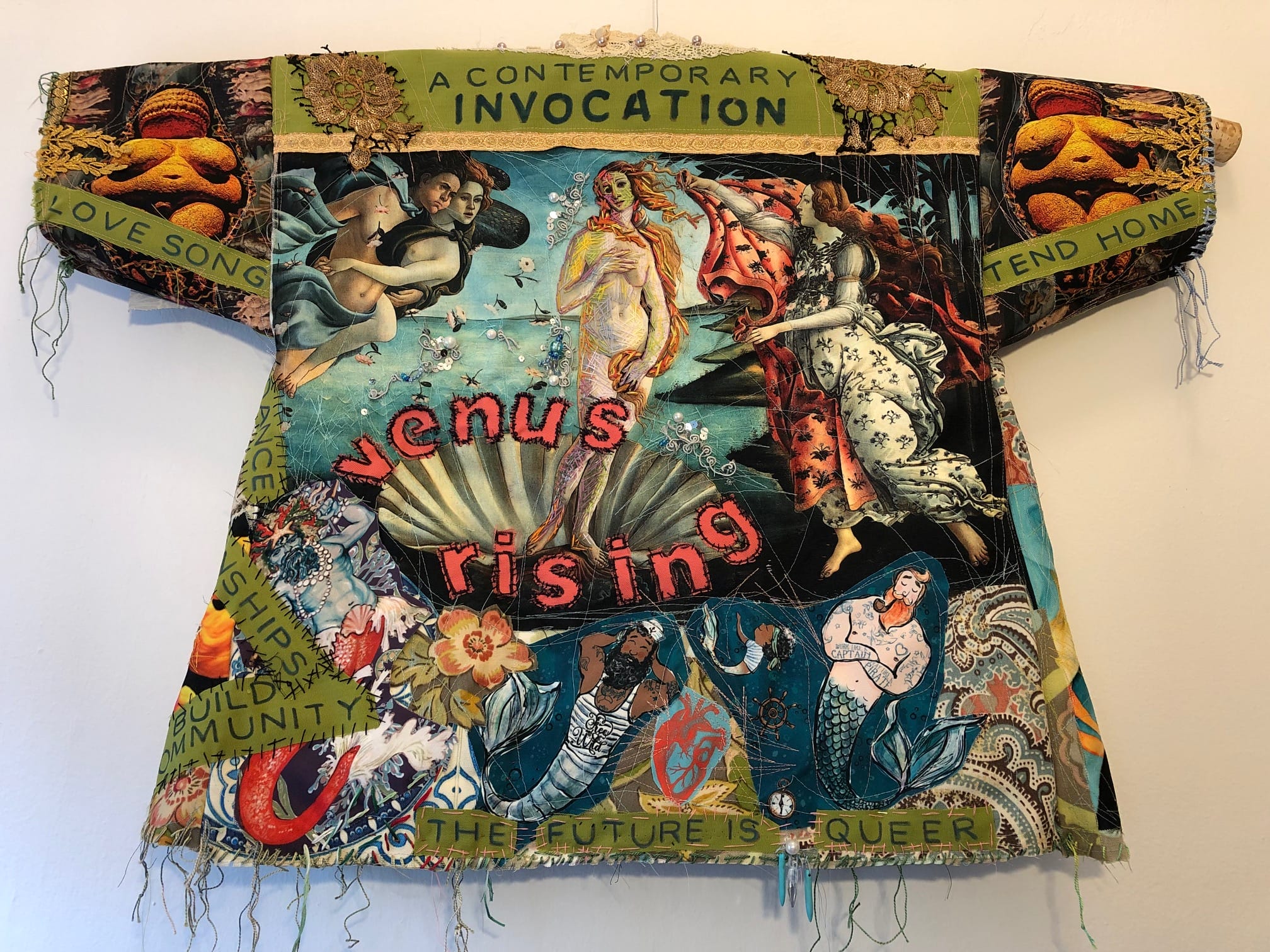
Genderqueer fiber artist, activist, art educator: can you tell me who is the artist Michael Sylvan Robinson and how his artistic practice talk about him?
I’m addressed Sylvan, using my full name professionally and for listings, but just Sylvan when we’re in conversation together. I use they / he pronouns. I’ve known myself as genderqueer for most of my life, though there have been times I kept that understanding more hidden from outward expression, and now at midlife feel very inspired and renewed in my self-embodiment in this generational expansion of gender expression and identity.
My work in the world is really an intersection of art, activism, and arts education, and all three of those pathways twined together in my early formative years as a young queer person in New York City of the late 80’s and early 90’s. Initially, I was a costume designer, a performance artist, and drag performer, and those experiences provided a great foundation for my fiber art practice of today! During those early NYC years, I participated in Queer Nation and ACT UP meetings and actions as many of my friends were dying of AIDS complications; being of service, caring for others and community, anchored much of my development as a person. Today, I’m an active member of Gays Against Guns, a nonviolent direct action group trying to stop the epidemic of gun violence. I bring my art to that work, creating memorial garments that have been worn in actions and memorial vigils. I research those killed by gun violence, and I try to share what I can learn about each individual’s life so that they are honored and remembered by our activism.
Where does your predilection for the textile medium come from – where and when did it begin?
One of the places I felt safest at college was the costume shop. As a young person I was very inspired by fashion and costumes, and as an 80’s teen there were so many gender noncomforming icons to be inspired by – Boy George, Annie Lennox, Prince – were some of the first music videos I remember seeing, and I wore makeup and deliberately genderfluid clothing during those years as I explored my creativity and personal identity. When I went back to earn an MFA at Goddard College, I turned my costume design and construction skills towards a more visual arts focused practice. I attended a professional development conference in Baltimore as part of my teaching work, and one of the presenters was the incredible Joyce J. Scott, she shared her interdisciplinary artistry and love of materials, including beadwork; I walked over to a local bead store right after the conference and came home with my first jars of brightly colored glass beads, which are an important component of my work to this day. I’m drawn to the decorative as a way of delighting the eye, but the beauty of my work is also an invitation to encounter the activist messaging or more challenging thematic projects that are part of my art-making.
Handwork is a major aspect of all my art-making; it is labor intensive, and sometimes I feel very much like a kind of faerie spider eagerly stitching away in bright colors and sparkling beads, and other times it feels very much like Rumplestiltskin spinning straw into gold with faster, tighter deadlines. My studio is in my home, and it helps me keep long-term projects moving even if I just get a little time in the studio when I get back from school.
Body, dress, identity: what do you think is the relationship between these elements and how are they declined in your works?
Often my work is about the absence of the body, creating sculptural garments that are memorial pieces, marking absences. My “Mourning Jacket for a Sweet Satyr: In Remembrance of Eric J. Ginman 11/13/69-7/19/97” was originally shared as a costume piece for the 2019 Bennington College 24 Hour Play Event, and through an amazing collaborative process with playwright Maia Villa and director David Drake, the memorial garment was incorporated into a new short play, Remembrance. This opportunity shifted me back into making clothing, and the piece was later shown at the Wisconsin Museum of Quilts and Fiber Arts. Eric and I were lovers both before I graduated from Bennington College and afterwards, and he died five years after his own graduation, in 1997 of complications from AIDS before he reached the age of 30. He’d sent me beautiful self-portraits which I held privately for years and then had printed onto silk as part of the textile collage process for this piece. Sometimes one puts the mourning down until there is space and presence to return to the ache of grief.
Initially when I returned back to the body, it was making activist and specifically memorial works to wear to actions and protests against gun violence as part of my work with Gays Against Guns, a nonviolent direct action group combatting the gun violence epidemic in the United States. I’m continuing a series of wearable art garments that arise from my ongoing research identifying and honoring individuals killed by guns, now starting a third year-specific memorial garment. I’ve worn these garments as part of actions and vigils, but more frequently they are displayed without someone wearing them which provides the viewer a sense of the empty spaces once held by the living.
Lately, I’m also making clothing that is fashion art with activist messaging through use of hand-embroidered or hand-beaded text; most notably showcased in the elaborate textile collage garment I designed for theater producer, Jordan Roth, to wear to the Met Gala in September, 2021, which was inspired by Roth’s original prose describing gender expression and identity worn like a garment, always in a state of manifesting and unraveling, changing. I got to work with an incredible team from Vogue magazine including editor Michael Philouze and master dressmaker, Bill Bull.

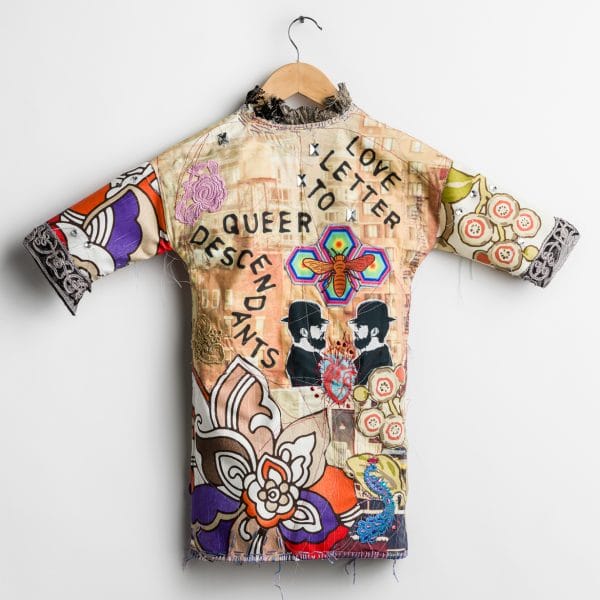
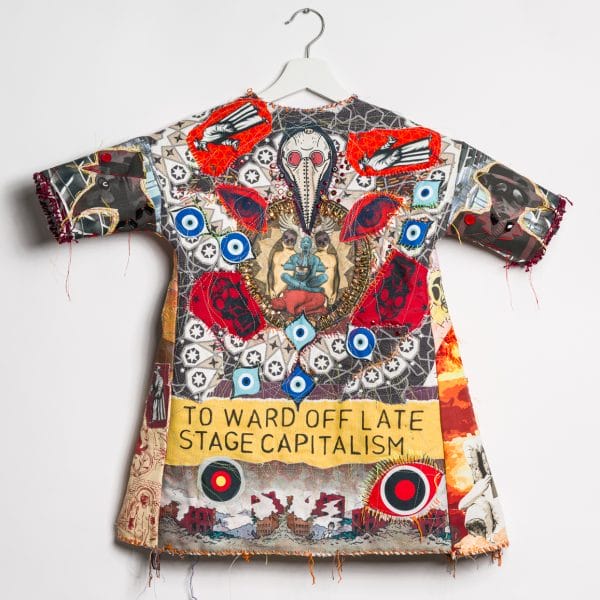
In addition to fabric, you use a lot of other materials. How do you choose them and do they have an intrinsic meaning, a semantic value themselves? And how many are recycled materials?
I’ll admit that I have a pretty keen eye and hand for the embellishments! Living in New York, I do invest in materials through the Garment District businesses when purchasing textiles. Since my work is about bringing small pieces together to create larger forms, I don’t need much yardage of any one fabric, and I think of some of my textile “ingredients” like a cook using saffron, a little goes a long way.
I do repurpose some of my materials, especially as people give me fabric or family items like vintage jewelry or buttons, sewing supplies. I’ve made works that are specifically designed with upcycled components or use alternative materials, but that’s not my main approach, though I greatly appreciate the artists and designers with those intentions more at the heart of their work and practice.
Your works are extremely dense and full of elements. How do they take shape and how do you proceed from the first idea to the finished work? And does this density have an assertive value?
I work on several pieces at a time, sometimes over a couple of years for larger works, as my process is very hand-labor intensive. Sometimes it can be several years before I get to an idea I’d sketched out earlier, but I’m also drawn to starting new things so there’s always lots of pieces “not quite finished,” and other works that come to fruition more promptly. I’ve also started to add some commissioned works to my practice, and those have processes specifically connected to the inspired (and inspiring) patron! I agree that my work is very intensely embellished, layered, one could even describe it as “overworked,” and there are times I consider what a “lighter touch” might mean for me. I really do want all the details to be special, bringing handwork to make every added layer uniquely realized. Use of text is in most of my work, but there are times that I chose not to use words or images as part of an approach to a specific series or piece.

How much autobiographical are your works? And how much are art and life intertwined for you?
I do have some specifically autobiographical work, but more often, I’m creating from an investigation of something that interests or challenges me, and trying to explore those themes in ways that invites others to consider, too. It is true that everything I make has a direct connection to my activism and spiritual practices as my art-making is a deeply anchored, personal practice.
How has your artistic work evolved over time?
Initially, as a costume designer, I had a signature use of very bold patterns and color work in my design and construction practice. After a fairly successful design focus both at school and in professional theater, I noticed that I preferred making clothes that weren’t always about a specific actor or role, and I went back to graduate school and shifted my costume design skills towards a more specific visual arts practice of fiber art, creating sculptural garments that weren’t meant to be worn as well as two dimensional works. Lately, I’ve reengaged making special clothing pieces that are wearable, too.
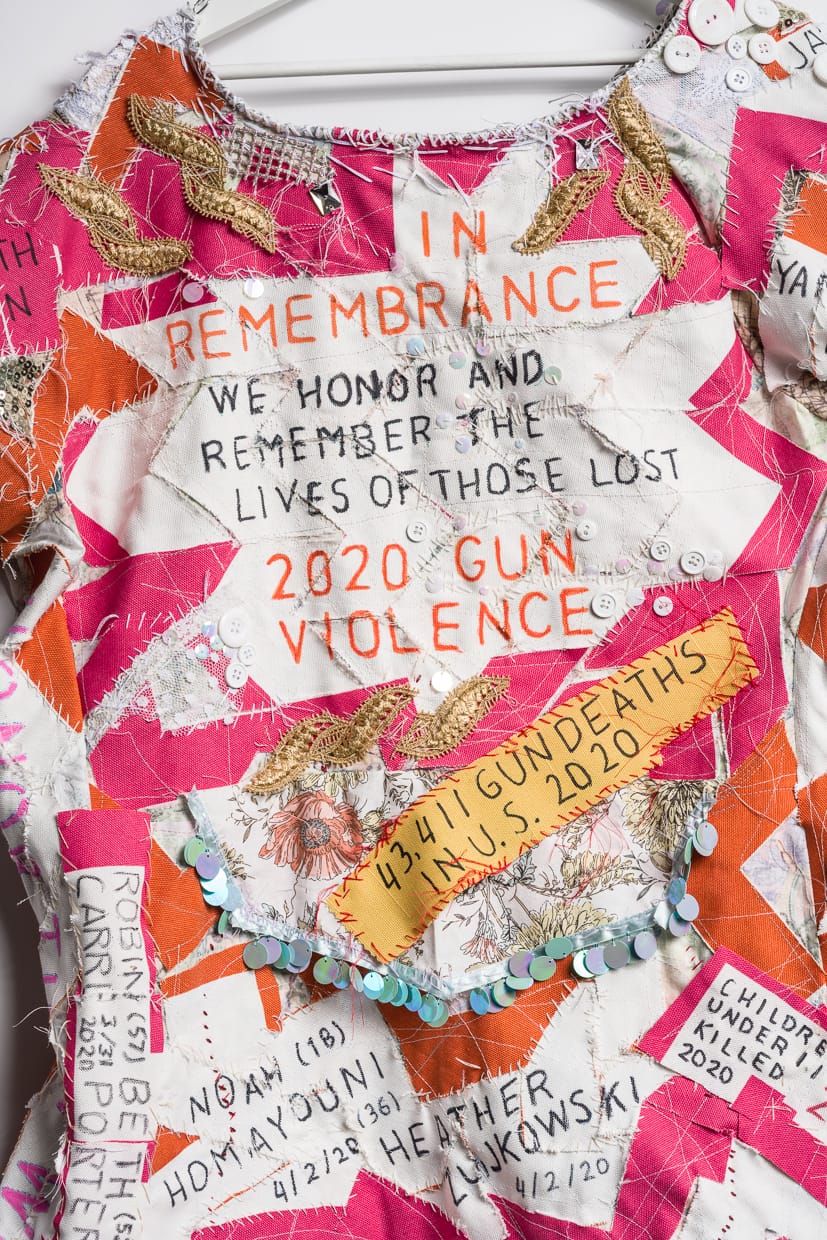
What is the work that represents you the most and why?
In many ways, the most “me” work I ever created was the art fashion garment commissioned and worn by Jordan Roth for the Met Gala. It is interesting that the piece was so personal for me, when it was created with Roth’s actual own words embroidered and beaded onto the surface of the textile collage, but the creation of this special work very much arose from our conversations together about fashion and gender, gender identity expression, and how those areas of exploration were important to Jordan’s approach to the theme of this year’s Met Gala. Everything I know how to do, and beyond anything I’d ever imagined to try, I got to explore through this incredible opportunity. It was really a life-changing experience!
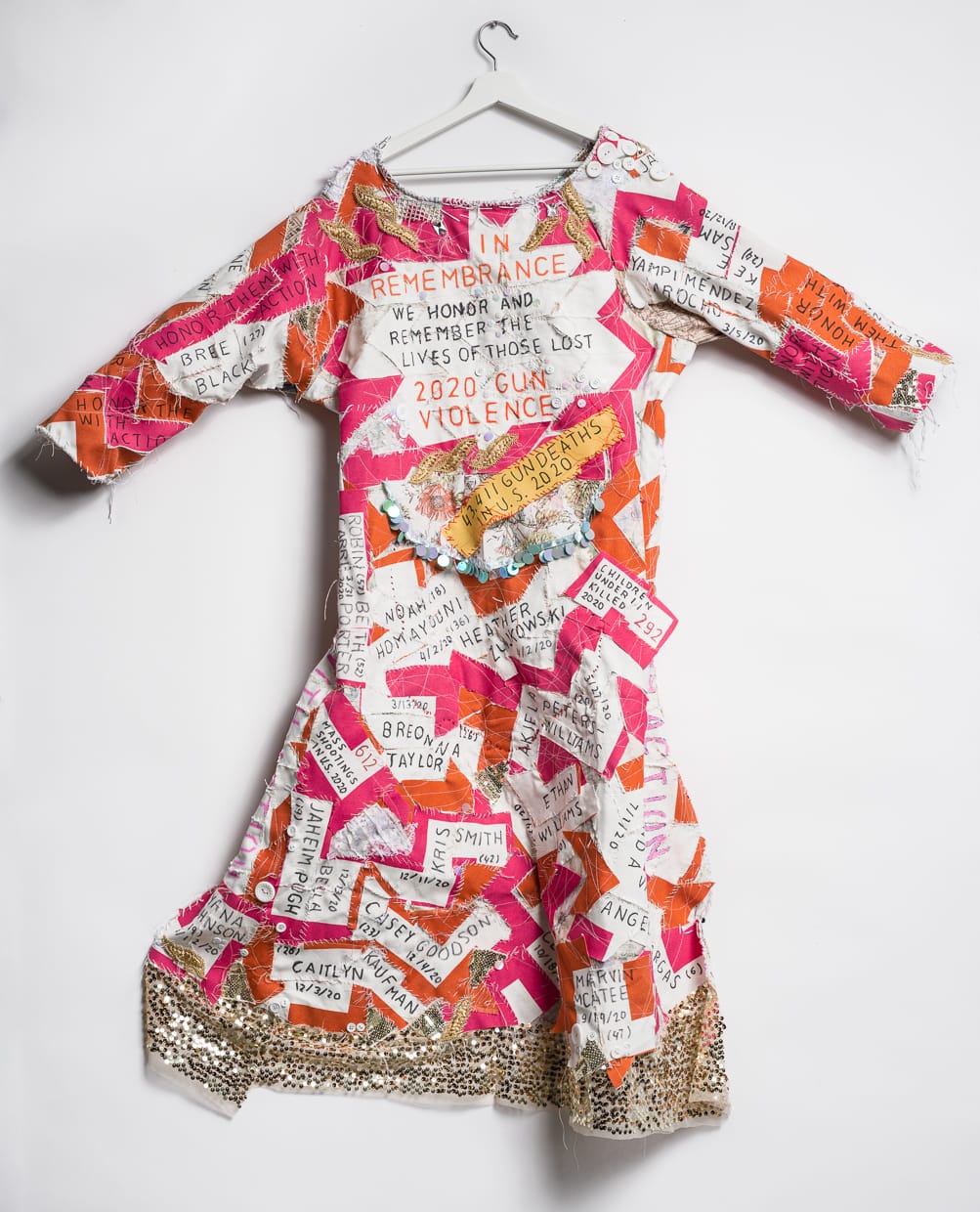
What are you working on and what are you planning for the future?
I’ve started a new series of small textile collage sculptural busts, an “oracle” series, and I’m super inspired by the process and the pieces so far; there’s definitely mending/repairing the ruins feeling to these works that is very evocative and timely, while the work is a deliberate, focused joining of very small hand-worked textile pieces, so very intimate and repetitive in a purposeful process. I was very much inspired by a recent trip to Rome and a visit to Pompeii. I’d remembered vividly a childhood trip to Pompeii, and this was an opportunity to experience the visit now with a strong art history background. In the unsettled times we live in, I’ve been considering the role of craft and artistry in response to the challenges of our era, like in my “to ward off late stage capitalism” piece from 2021 that was exhibited in the SPRING / BREAK Art Show this fall.
Also, after a bit of a longer delay than I’d intended, I’m resuming some more specific fashion art, wearable works evolving from the Met Gala commissioned garment I designed for Jordan Roth. I’m working now with costume designer, Kim Griffin, who helped assist me with the Met Gala garment, on a min-collection of capes for my “protective wear for urban faeries” series. I’m also excited to be joining Bennington College, as a guest faculty member (and alum) in the fall, teaching a course in art/fashion/activism that will culminate in a collaborative, intergenerational art fashion show project!
